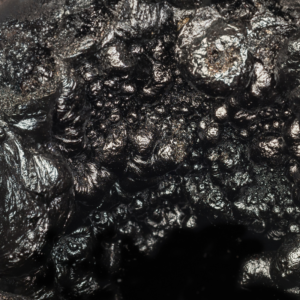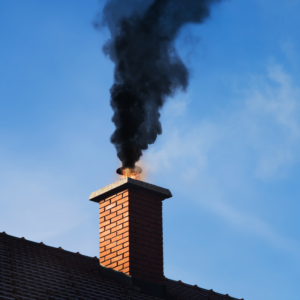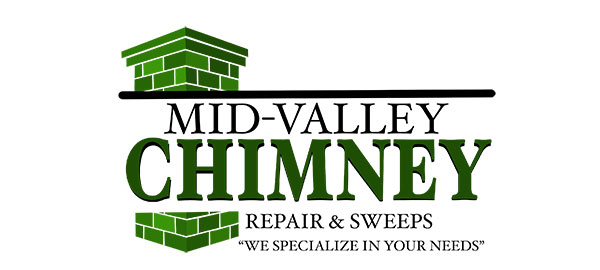You may not know it, but your chimney could be posing a silent danger to you and your family. Creosote may be building up inside the flue, waiting to be ignited. Creosote is the leading cause of chimney fires and poses a real threat to your home and to your family.
Mid-Valley Chimney Repair & Sweeps believes you should be able to enjoy your fireplace without the worry of creosote buildup and chimney fires. Here is what you need to know about creosote, chimney fires, and how to avoid them.
What Is Creosote?
 The wood that you use to burn the fires in your fireplace produces different chemicals, gases, tar fog, and minute particles that don’t burn cleanly or completely. These particles rise up through your chimney with the smoke from your fire. As it all rises, it cools and condensation forms on the walls of your chimney, leaving these sticky particles that cling to its interior.
The wood that you use to burn the fires in your fireplace produces different chemicals, gases, tar fog, and minute particles that don’t burn cleanly or completely. These particles rise up through your chimney with the smoke from your fire. As it all rises, it cools and condensation forms on the walls of your chimney, leaving these sticky particles that cling to its interior.
This byproduct from your fireplace fire is called creosote.
Creosote is a highly combustible byproduct that as it builds up can restrict smoke from passing through the chimney and poses a high risk of igniting. Once ignited, your chimney will be host to a fire inside it that can burn at temperatures of over 2100 degrees F. That is hot enough to crack clay tiles, bricks, and mortar.
There are three different stages of creosote buildup.
- Stage 1 (First Degree Creosote): At this stage, creosote has a light and flaky quality. A professional chimney sweep can easily sweep it off the inside of the chimney using a rotary cleaning brush. Left unattended, however, the creosote will continue to accumulate and become a problem.
- Stage 2 (Second Degree Creosote): When your creosote buildup has reached stage two it will become sticky, like tar. While there will still be some flakes of creosote present, it will resemble a black and goopy substance that clings to the walls on the inside of your chimney. It is much harder to remove and may require some special tools from professional chimney sweeps.
- Stage 3 (Third Degree Creosote): Stage three creosote buildup is the hardest to clean. The sticky, tar-like residue from stage two has now hardened and formed a smooth, shiny layer of creosote on the inside of your chimney. It is the hardest to remove and poses the most danger to your chimney and to your home.
I’ve Had a Chimney Fire! What Should I Do?
If the creosote in your chimney has ignited you are experiencing a chimney fire, get your family and yourself out of your house immediately, and call the fire department to the premises as quickly as possible. Chimney fires can be extremely dangerous due to the high heat at which they burn and their ability to spread to other parts of your home quickly.
If you have noticed a chimney fire, do not try to extinguish the fire yourself. Firefighters are trained and have the proper equipment to put out the fire and keep your chimney and home from further damage. The safety of you and your family is paramount. Get out at once.
How Can I Avoid Chimney Fires?
Creosote buildup is almost exclusively the culprit in chimney fires. While you can’t completely stop creosote from forming inside your chimney, there are actions you can take to slow the process of the buildup and avoid chimney fires in the future.
✓ Burn only dried, well-seasoned firewood.
 The drier the firewood that you use, the more efficient your fires will be. This means fewer combustible byproducts will be released with the smoke that goes out your chimney – and less creosote will form overall.
The drier the firewood that you use, the more efficient your fires will be. This means fewer combustible byproducts will be released with the smoke that goes out your chimney – and less creosote will form overall.
Freshly cut firewood has a much higher moisture content which will create a thick smoke filled with all sorts of combustible material. The process of creosote buildup is much faster when unseasoned wood is used.
✓ Maintain proper air flow
By spacing your wood evenly while you burn it, air is able to flow through it better. Also, make sure your damper is fully open and that air can come in, while your smoke is able to get out. If your home is well insulated, cracking a window can also help invite in some make-up air and keep the air flowing through your home as you burn.
✓ Regularly sweep and inspect your chimney
By far the greatest tool in your chest for preventing chimney fires is your friendly neighborhood chimney sweeps from Mid-Valley Chimney Repair & Sweeps. Armed with proper tools and vast creosote knowledge, we can sweep and inspect your flue, leaving you with peace of mind and fewer worries.
Stay Safer This Fall – Reach Out Today
There’s not much that tops enjoying a warm fire on a cold night. The gentle crackling of the burning wood, that soft glow, and warm flames dancing in the fireplace are part of what make a house a home. And a well-maintained, regularly-cleaned fireplace can provide generations worth of cozy nights.
Mid-Valley Chimney Repair & Sweeps is certified by the Chimney Safety Institute of America (CSIA) and members of the National Chimney Sweep Guild (NCSG), and our team of experienced technicians desire your safety above all else. Call us today at 513-727-0994 or schedule a chimney sweeping and inspection online today.
